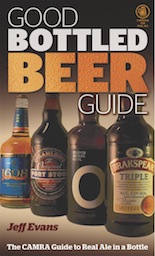
CAMRA Books, Soft cover, $19.95, 320 pp.
I hesitate to call Jeff Evans a veteran beer writer for fear he points a bony finger at the date on my birth certificate. But Jeff has been around the beer scene since the early 1990s and earned his spurs as a distinguished editor of the annual Good Beer Guide.
His main claim to fame and admiration is the Good Bottled Beer Guide. Admiration, because when he wrote the first of seven editions back in 1998, bottled beer was falling off a cliff in Britain and Jeff lauded one tiny section of that small sector: bottle-conditioned ales. Today, bottled beers are carving out an even greater share of the British beer market and craft brewers are rushing to package their beers with live yeast. Jeff, in short, has put the bottle back into bottle.
Does it matter whether beer in a bottle is filtered or contains live yeast? Jeff—and I agree with him—says an emphatic “yes.” When I open a bottle of Woodforde’s Wherry Bitter to discover a rim of yeast in the neck, I know I face the pleasure of rich aromas and flavors (I also consume the yeast because it’s good for me).
There’s excitement connected to drinking beer that has quietly matured and aged gracefully. Some years ago, Jeff and I shared a bottle of the iconic IPA from Burton-on-Trent, Worthington’s White Shield, which, with great self-sacrifice, I had left in my cellar for 10 years. The beer was darker, fruitier and spicier than a young version of the beer and it made for a fascinating drinking experience. You won’t get that with a filtered and pasteurized bottle from Global Corps Brewers, Inc.
Jeff writes well and succinctly. He has a good nose and palate and teases out the character of each beer in a style that lacks pretension. I open the book at random and immediately want to sample the Fox Brewery’s Drop of Real Norfolk: “Tart, fruity hops, with bitter orange and grapefruit flavors, fill the aroma, and sharp grapefruit then continues into the taste, which is mostly bitter and slightly perfumed, with background sweetness from silky pale malt. Sharp citrus hops feature in the drying finish, with bitterness building.” It’s a description that draws you enticingly into the beer.
Previous editions of the guide were arranged alphabetically but now Jeff has—wisely, I feel—broken the book down into styles. The result gives you not only information about the chosen beers but a journey round the great styles of Britain, from mild to barley wine and takes in the likes of golden ale, IPA, porter, stout and old ale. There are even sections on lager and wheat beer: Yes, brewers in Britain are not only making lager but are producing them in bottle-conditioned format. The beer world is changing fast this side of the pond.
The book is not confined to the British Isles. There’s a section on bottle-conditioned beers brewed in the United States, Belgium (of course), Australia and even France, along with helpful advice on the distributors who can obtain beers for your delectation.
The book is beautifully designed and illustrated in full color. It’s a delight from start to finish, a fine contribution to our appreciation of good beer, written by an inspirational writer.









